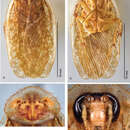Arenivaga adamsi
(
Russo
)
fornecido por wikipedia русскую Википедию
Латинское название
Arenivaga adamsi Hopkins, 2014 
Систематика
на Викивидах

Поиск изображений
на Викискладе
Arenivaga adamsi (лат.) — вид песчаных тараканов-черепашек рода Arenivaga из семейства Corydiidae (или Polyphagidae)[1]. Обнаружены в Северной Америке: США и Мексика (центральная часть пустыни Сонора и северная часть Sinaloa Mexico и юго-восточная Аризона)[2].
Описание
Среднего размера тараканы овально-вытянутой формы: длина тела от 15,8 до 20,7 мм; наибольшая ширина тела (GW) 7,3-10,3 мм; ширина пронотума (PW) 5,47-6,33 мм; длина пронотума (PL) 3,60-4,57 мм. Соотношение длины тела к его наибольшей ширине у голотипа = TL/GW 1,94. Основная окраска оранжево-коричневая (песчаная). Имеют по 2 коготка на лапках. Ноги средней и задней пары покрыты шипиками [2]. Обитают в песчаной почве, песчаных дюнах. Питаются, предположительно, как и другие виды своего рода, микоризными грибами, листовым детритом пустынных кустарников и семенами, собранными млекопитающими. В надземных условиях живут только крылатые самцы (отличаются ярко выраженным половым диморфизмом: самки рода Arenivaga бескрылые, внешне напоминают мокриц). Вид был впервые описан в 2014 году американским энтомологом Хейди Хопкинсом (Heidi Hopkins) и назван в честь Дугласа Адамса (Douglas Adams)[2].
Примечания
- licença
- cc-by-sa-3.0
- direitos autorais
- Авторы и редакторы Википедии
Arenivaga adamsi: Brief Summary
(
Russo
)
fornecido por wikipedia русскую Википедию
Arenivaga adamsi (лат.) — вид песчаных тараканов-черепашек рода Arenivaga из семейства Corydiidae (или Polyphagidae). Обнаружены в Северной Америке: США и Мексика (центральная часть пустыни Сонора и северная часть Sinaloa Mexico и юго-восточная Аризона).
- licença
- cc-by-sa-3.0
- direitos autorais
- Авторы и редакторы Википедии
Description
(
Inglês
)
fornecido por Zookeys
Male. Measurements. Holotype TL = 17.5 mm, GW = 9.0 mm, PW = 6.13 mm, PL = 4.33 mm, TL/GW = 1.94, PL/PW = 0.71. EW = 0.30 mm; OW = 0.30 mm. Among paratypes range of TL 15.8–20.7 mm; range of GW 7.3–10.3 mm; range of PW 5.47–6.33 mm; range of PL 3.60–4.57 mm.
Head. Two ocelli large, ovoid and protruding (0.40 × 0.30 mm); vertex dark brown with small ridges in rays around upper apices of eyes and extending onto ocellar tubercles; interocellar space concave, medium brown. Frons translucent peach-brown, unusually wide, posterior concave; anterior portion of frons bulbous and translucent peach-brown; translucent peach-brown smooth anteclypeus. See Fig. 12d.
Pronotum. Pronotum translucent waxy beige; dorsal surface of pronotum with short orange-brown setae that are thicker and longer laterally; pronotal pattern orange-brown or red-brown “panther face”, with scattered maculations of same color as pattern; discernible detail within pattern variable; slight aura. See Fig. 12c.
Body. Wing brace present. Two tarsal claws present. Legs and body light orange-brown; many specimens with brown maculations laterally on each sternite; subgenital plate light orange-brown; asymmetrical with rounded apices. See Fig. 12b.
Forewings. Wings extended well beyond abdominal apex (up to 40% of wing length); blotchy medium to dark brown depending on specimen; surface matte and opaque. See Fig. 12a.
Genitalia. Right dorsal phallomere composed of lightly sclerotized, long, bulbous hook-shaped lobe, articulated with right ventral phallomere on lateral side; medial side of lobe deeply emarginated from medial edge of remainder of phallomere; central field shallow, cupped, lightly sclerotized; medial margin more heavily sclerotized, smooth, with long posterior projecting spine. Small central sclerite punctate, with large shagreened, rugose, medially projecting bilobed bulge; right ventral phallomere extends from articulation to form shagreened rounded structure, with prominent medially projecting spine located posteriorly; attached anteriorly is mildly dorsally projecting flanged smooth concave arm, that extends only slightly beyond depth of rest of phallomere, apex punctate. Folded anterior portion of left phallomere dramatically modified with sclerotized anterior wall and posteriorly projecting setose spine located ventrally. Genital hook with short extension to pointed head with moderate hook; arm smoothly curved. See Fig. 13.
- licença
- cc-by-3.0
- direitos autorais
- Heidi Hopkins
- citação bibliográfica
- Hopkins H (2014) A revision of the genus Arenivaga (Rehn) (Blattodea, Corydiidae), with descriptions of new species and key to the males of the genus ZooKeys 384: 1–256
- autor
- Heidi Hopkins
Distribution
(
Inglês
)
fornecido por Zookeys
This species is found in central Sonora and northern Sinaloa Mexico and southeastern Arizona. See Fig. 14.
- licença
- cc-by-3.0
- direitos autorais
- Heidi Hopkins
- citação bibliográfica
- Hopkins H (2014) A revision of the genus Arenivaga (Rehn) (Blattodea, Corydiidae), with descriptions of new species and key to the males of the genus ZooKeys 384: 1–256
- autor
- Heidi Hopkins


![]()